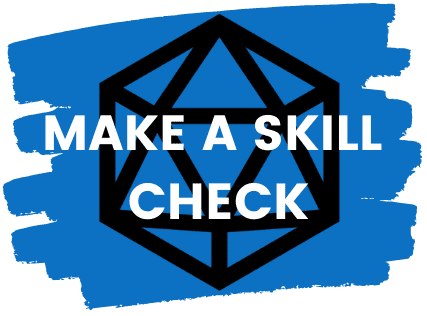On the go? Listen to the audio version of the article here:
Many new DnD 5e players may be confused as to what the spot on their character sheet reserved for “Hit Dice” means. Is it just more Hit Points (HP)? Is it what you use to hit someone? All will become clear if you keep reading, including how to best use Hit Dice.
Hit Dice—short for Hit Point Dice—are used to decide a character’s max HP each level and to heal when taking short rests. Each class has a set amount and type of dice; regain half their max each long rest. E.g., a Lvl 10 Bard has 4/10 left; they long rest and now have 9.
Some classes share the same type of die (d6, d12, etc.), but the basic mechanics remain the same. Curious to learn more? Let’s dive in.

Table of Contents
How do Hit Dice Work?
The type of Hit Dice that your character has is determined by their class. You can find the information specific to your class under Class Features in the Player’s Handbook. The type ranges from a six-sided die (1d6) to a twelve-sided die (1d12) as follows:
- Sorcerers and wizards: 1d6
- Bards, clerics, druids, monks, rogue, and warlocks: 1d8
- Artificers, fighters, and paladins: 1d10
- Barbarians: 1d12
At 1st level, you have one of your class’ Hit Dice. So, if you’ve just created a wizard, go ahead and write down 1d6 on your character sheet in the Hit Dice section.
For every Hit Die that you get, your max HP increases. At 1st level, you are given the maximum of your die plus your constitution (CON) modifier. So, a wizard with a CON modifier of +1 starts with a hit point maximum of 7.
How to Increase Hit Points When Leveling Up
When the time comes that your Dungeon Master (DM) says your character has leveled up, your character gets another Hit Die. If you’re a 2nd level wizard, now you have 2d6!
Since you received a new Hit Die, your hit point maximum changes. You don’t automatically get the maximum after 1st level. This time, you have a choice: roll the Hit Die or take the average of the roll (rounded up).
If you take the average, you will consistently get a good amount of health. If you roll, you could get the maximum amount every time, or you could roll a 1. Ouch.
Either way, add the result of your choice plus your CON modifier to your hit point maximum. Make sure to increase your current hit points by the same amount as well.
For example, our 1st level wizard has a hit point maximum of 7. She fought some goblins and took six points of damage.
Her current HP was down to 1. Then she leveled up and rolled a 5 on her Hit Dice. With a CON modifier of +1, her hit point maximum increases by 6, to a total of 13.
Her current HP also increases by 6, so she now has 7 of her 13 HP total.
If our wizard decides to multi-class, she gets the hit dice of her new class when she levels up. For example, a character with 4 levels in wizard and 3 levels in fighter will have four d6 Hit Dice and three d10 Hit Dice.
Every time you level up, you get another one. But now that you have them, how can you use them? To heal using your Hit Dice, you need to take a short rest.
What are the Rules for Using Hit Dice to Heal in 5th Ed?
You’ve encountered some foes and taken some damage. How do you regain those precious hit points back? Besides healing spells and Potions of Healing, you can recover by taking a short rest.
A short rest is an hour or more of downtime in which your character doesn’t take part in any strenuous activity. If you’re unconscious, you still benefit from a short rest!
For the next hour, the party sits around and takes a breather. You pull out some jerky from your pack and chow down. Perhaps you write down the legend of the battle you just fought for posterity’s sake.
At the end of your short rest, you can recover hit points by spending the Hit Dice that you have.
Roll one of your Hit Dice and add your CON modifier to the result of the roll. Congrats! That’s how much you heal. If you still don’t have as much HP as you would like, roll your next Hit Die and add your CON modifier to the result.
It is important to roll them individually, rather than all at the same time. If you roll particularly well, you might heal yourself for more than necessary, wasting this resource.
You cannot have more hit points than your hit point maximum (well, except for Temporary Hit Points). Heal yourself more than that, and it’s as useful as a solar-powered flashlight—not at all.
When you use a Hit Die in this way, it’s spent. You regain up to half your total Hit Dice when you take a long rest, with a minimum of 1 Hit Die regained.
Negative Constitution Modifiers and Hit Dice
Jeremy Crawford, a lead designer of DnD 5e, has specified that it is possible to lose hit points as you level up if you have a negative CON modifier.

If, when you level up, you roll a 2 on your Hit Die, and you have a -3 to your CON modifier, your hit point maximum decreases by 1. You always have the option of taking the average roll—4 for a wizard—and this is highly recommended unless you want to roleplay a character with a terminal illness.
When you heal using your Hit Dice, a negative modifier will not decrease your current HP, but it could stop you from healing. If you roll a 2 and have a -3 CON modifier, you don’t regain any health.
Optional Rule: Healing Surges
The Dungeon Master’s Guide offers an optional rule to use in your games called Healing Surges. This allows players to use their action in combat to use their Hit Dice to heal themselves as if they were taking a short rest.
This is a useful rule to implement at your table if your party does not have a dedicated healer or if magical healing is a rare thing in your world.
As always, ask your DM if they would consider implementing this rule.
Summary
What are Hit Dice good for? Keeping your character alive!

The basics:
- You gain a Hit Die for every level that you gain in the game
- The type of die is determined by your class
- Every time you level up, roll your Hit Dice to change your maximum HP, or take the dice average rounded up—this typically means half, plus one.
- Negative CON modifiers can make you lose max HP when you level up, and can cancel healing while taking a short rest.
- You regain half your maximum Hit Dice (minimum of 1) when you take a Long Rest.
- Healing Surges – an optional rule in combat that allows you to spend your Hit Dice to heal, mid-combat. Especially worth considering if your party has no healers.
And when you’re resting, you can roll your Hit Dice to recover HP, even if you’re unconscious.
Now all you have to do is remember to use them!







0 Comments
Trackbacks/Pingbacks